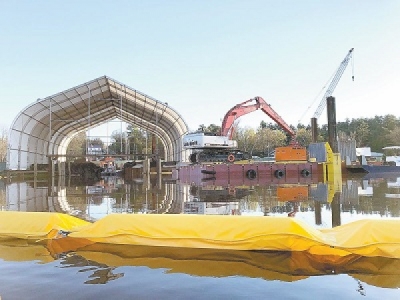
Posted on May 22, 2018
By Glynis Hart, Adirondack Daily Enterprise
Pontiac Bay Superfund site cleanup moves from the preparation stage to the dredging phase this week, now that the 50-foot-high white structure covering the loading site is up.
State Department of Environmental Conservation spokesman Dave Winchell said when they finally get this done, Pontiac Bay and Lake Flower will be a much healthier place.
“The habitat will be much better,” he said, “not only because the contaminants will be gone, but because we’re going to do restoration of the habitat. It will be better for fish and aquatic life.”
Although the blue waves of the village’s central waterbody look clean enough, the area where Brandy Brook flows into the lake is contaminated with products from an coal gas manufacturing plant. Once upon a time, the gas plant supplied light and electricity to the village. Natural gas (i.e., methane) replaced coal gas as a light source during the early 1900s, as it was easier and cheaper to handle. In its turn, natural gas was replaced by hydropower, coal-burning plants and the whole modern pantheon of energy producers. The gas plant was closed, the building torn down, and the era of coal-gas lights was forgotten.
For many years, the public beach at Lake Flower invited unsuspecting swimmers to the cool waters above the coal gas byproducts. Former Mayor Howard Riley remembers hiring lifeguards for that beach in the 1960s. No one suspected that the contaminants in the bottom of the bay posed a danger to the people swimming there.
“That would be awful,” said Riley, “if it made people sick. Thousands of people swam there.”
The village gets its drinking water from two wells; there’s no risk to that water supply.
However, finding out whether a substance somebody was exposed to 50 years ago caused them to get cancer is nigh unto impossible. National cancer tracking sites tally cases by location, but do not keep data on how long people lived there, or where they may have lived before.
Thus, a worker who was exposed to carcinogens in Seattle and developed cancer 20 years later in Las Vegas would be counted in cancer statistics for Las Vegas. If people got cancer from swimming in Lake Flower, it would be hard to prove.
Winchell could only say, “It’s possible.”
“It’s not inert,” DEC environmental remediation engineer Russell Huyck said of the coal gas byproducts. “It’s not immobile; it’s at the surface in different locations.
“If you were to drop an anchor in certain locations, you would see a plume of it arise.”
Such are the dangers of contact with these chemicals: benzene, toluene, xylene, ethylbenzene and others. Benzene, a carcinogen, dissolves in water, so any child, for instance, who played at spitting lake water upon his comrades ingested it. The U.S. Environmental Protection Agency puts the safe level of concentration for benzene at less than 1 part per billion, roughly the amount of a teaspoon in an Olympic-sized pool.
Workers have isolated the site with bright yellow floating booms. Although you can’t see them from above the water, silk curtains hanging from the booms contain the sediments disturbed by the dredging process, to keep them from floating away.
Upstream, a turbidity monitor measures sediments flowing toward the dredging site. Directly downstream, another turbidity monitor measures sediments that might come from the site.
“If that turbidity alarm indicates higher than background levels, they investigate,” said Huyck.
In order to remove the sediments under the water, workers will section off the bay.
“They’ll be working in a cell where the waste material is, where it can be contained and prevented from disbursing in the water,” said Huyck.
A crane will scoop out the material in each section, one at a time, move it to one of three vessels — they look like floating boxes — and the vessels will be pushed to the large white “sprung structure,” where the material will be unloaded to drain.
“In the future there’ll be a water treatment device,” said Huyck, “to treat the water running off the sediments.”
Next, the material will be loaded into trucks and taken away.
Huyck said Wednesday that the preparation phase of construction is nearly complete. Huyck and site workers were expecting an air filtration system for the structure to arrive that afternoon. “This is all still preparation,” he said.
Source: Adirondack Daily Enterprise





